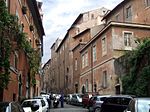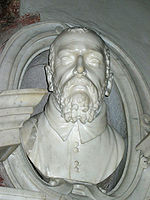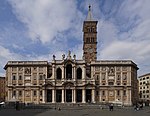Torre dei Capocci

Torre dei Capocci (Engl.: "The Tower of the Capocci") is a tower at San Martino ai Monti square in Rome, Italy.Torre dei Capocci, along with Torre dei Graziani, constitutes a kind of monumental entrance to top of the hill Esquilino. Built by the family of Arcioni in the 12th century, it afterwards went to the Capocci, a noble family from Viterbo. These erected around the tower a number of houses, which no longer exist, but which made the building a sort of citadel. The tower is 36 m (118 ft) high with seven floors, a square base, and windows framed in travertine. The terrace, bordered by a brick parapet, is edged by crenellated battlements on each side, and emerges at the output hopper of the staircase.
Excerpt from the Wikipedia article Torre dei Capocci (License: CC BY-SA 3.0, Authors, Images).Torre dei Capocci
Piazza di San Martino ai Monti, Rome Municipio Roma I
Geographical coordinates (GPS) Address External links Nearby Places Show on map
Geographical coordinates (GPS)
| Latitude | Longitude |
|---|---|
| N 41.8949 ° | E 12.4976 ° |
Address
Torre dei Capocci
Piazza di San Martino ai Monti
00184 Rome, Municipio Roma I
Lazio, Italy
Open on Google Maps











